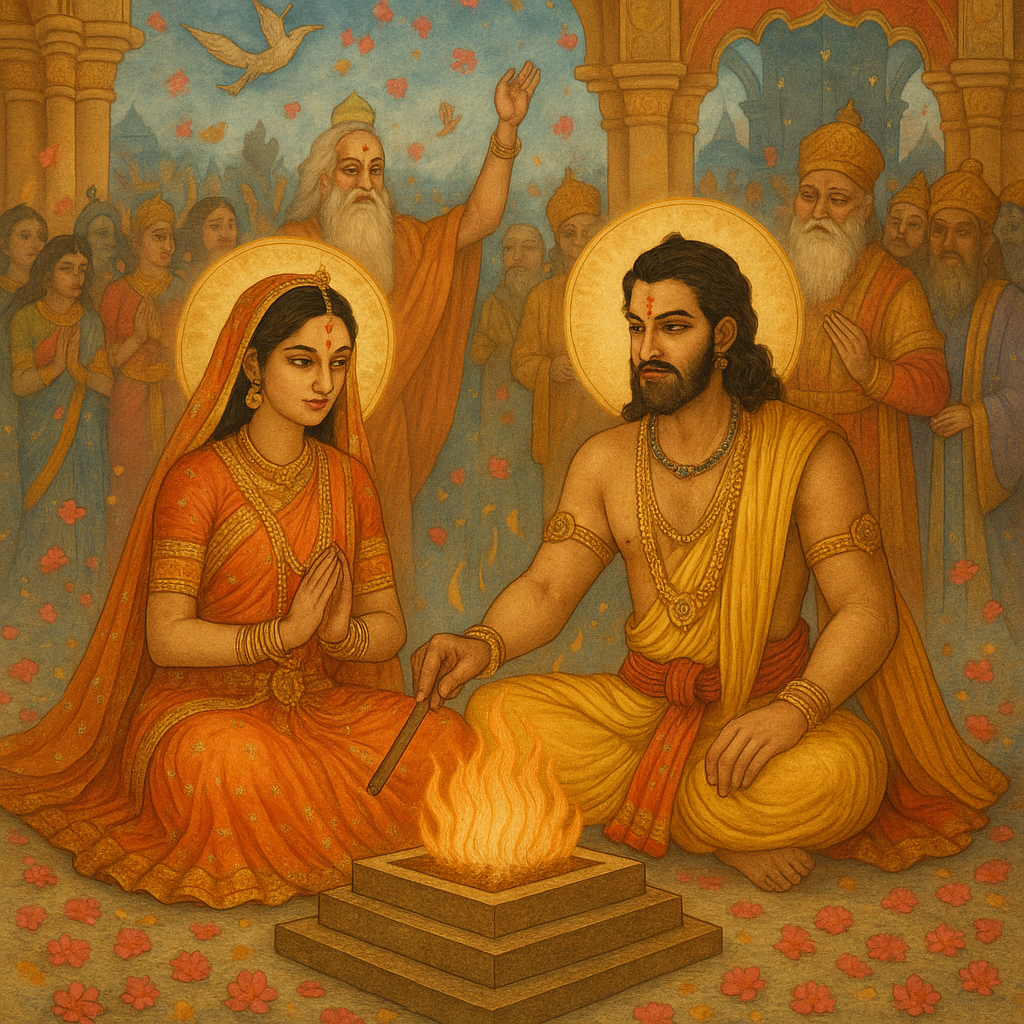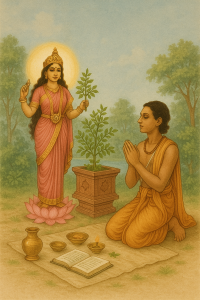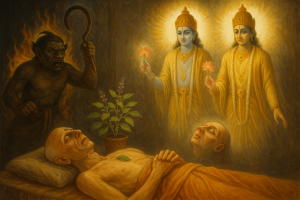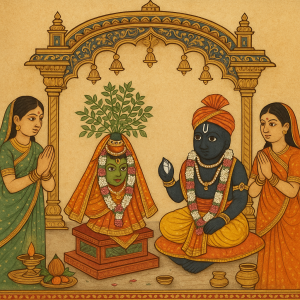The Divine Union
After their heartfelt conversation in Badarikāśrama, Tulasī Devī and Śaṅkhacūḍa, both radiant with divine love and memory of their eternal connection, prepared for their sacred union.
Śaṅkhacūḍa, who had been living in the forest and performing austere penances, now bathed and adorned himself in fresh garments. He tied his divine amulet, Sarvamaṅgalamaya, around his neck—an ornament of celestial origin gifted by Lord Brahmā himself, ensuring protection and victory.
He then placed Tulasī upon his golden chariot, decorated with heavenly jewels, and the two departed for the palace of King Dharmadhvaja, her father. The chariot sped through the skies, guided by celestial beings, filling the heavens with a soft divine glow.
The King’s Joy
Upon arriving at the palace, Śaṅkhacūḍa was welcomed with great pomp. King Dharmadhvaja was overwhelmed with happiness upon seeing his daughter return with such a majestic and noble companion.
Recognizing the marks of a great devotee and a king on Śaṅkhacūḍa’s body—and aware of Lord Brahmā’s prophecy—the king gladly consented to the marriage. The palace filled with celebration, divine sounds, and festivities.
The Gandharva-vidhi, the sacred Vedic rite of celestial marriage based on mutual love and acceptance, was performed with auspicious mantras, sacred fire, and blessings from the sages.
Joyous Celebration and Divine Bliss
Tulasī and Śaṅkhacūḍa became husband and wife. The earth rejoiced. Celestial beings showered flowers from the skies. The couple spent time in the palace with great joy, sharing affection, wisdom, and mutual devotion.
For many days, they remained there, delighting in one another’s company. Tulasī, the embodiment of purity and chastity, served Śaṅkhacūḍa with full dedication, and he in turn honored her with gentle love and spiritual affection.
Their marriage was not simply based on bodily pleasure, but founded upon dharma, service to the Supreme Lord, and remembrance of their eternal past in Goloka Vṛndāvana, where they had once served Lord Kṛṣṇa together.
The air was filled with the fragrance of sandalwood, the sounds of auspicious music, and the chatter of delighted guests. Kings, sages, and demigods praised the wedding as a union of two eternal associates who had taken birth on earth for a divine purpose.
Lessons to Be Learned
1. Marriage in Bhakti is a Sacred Partnership
Tulasī and Śaṅkhacūḍa’s union was not based merely on physical attraction or material gain. It was a divine, spiritually grounded partnership aimed at supporting one another’s devotion. Śrīla Prabhupāda often emphasized that gṛhastha life, when centered around Kṛṣṇa, becomes a sacred āśrama, not a distraction.
“When husband and wife live together in Kṛṣṇa consciousness, they become a powerful spiritual team.” – Śrīla Prabhupāda
2. The Gandharva Marriage Rite Reflects Spiritual Equality
Their marriage followed Gandharva-vidhi, where mutual consent and love are the foundation. This shows that in the Vedic tradition, marriages based on genuine spiritual connection and virtue were honored, especially among devotees.
3. The Amulet Symbolizes Divine Protection for the Devotee
Śaṅkhacūḍa’s protective amulet, a gift from Lord Brahmā, illustrates how the Lord always empowers His devotee to carry out a divine mission. When one is engaged in the Lord’s service, divine strength and protection are assured.
4. Family Joy Comes From Spiritual Reunion
King Dharmadhvaja’s joy was not simply due to material success, but because his daughter had united with a spiritually exalted husband. Real family happiness comes not from wealth or social status, but from alignment with spiritual destiny and devotional character.
5. Remembrance of Goloka Is the Soul of Devotion
Though now on Earth, both Tulasī and Śaṅkhacūḍa remembered their eternal forms in Goloka Vṛndāvana, serving Lord Kṛṣṇa. The devotee should always remember that this world is temporary, and our real home is the spiritual world, where loving service to the Lord is eternal.
6. Marriage Is a Means, Not the Goal
Their sacred marriage served a greater divine purpose. Śrīla Prabhupāda taught that gṛhastha life is a platform for purification and service—not an end in itself. Tulasī and Śaṅkhacūḍa remind us that love in this world becomes perfect when offered to Kṛṣṇa.



